When all Bitcoins are mined, which is expected around 2140, the dynamics of the network will change dramatically. Miners will no longer receive block rewards, so their income will depend solely on transaction fees. This shift could increase transaction costs, impacting users. As the supply becomes capped at 21 million, Bitcoin's scarcity may drive demand and value up, making it more appealing as a store of value. However, it also raises concerns about network security and miner incentives. Curious about how these changes could affect Bitcoin's future and your investments? There's more to explore.
Key Takeaways
- When all Bitcoins are mined, the total supply will reach the capped limit of 21 million coins, preventing further issuance.
- Miners will rely solely on transaction fees for income, as mining rewards will cease post-2140.
- The scarcity of Bitcoin may drive up demand and value, impacting market dynamics significantly.
- Increased reliance on transaction fees could threaten network security if they don't sufficiently incentivize miners.
- Bitcoin's fixed supply may create volatility and speculation risks as market conditions change over time.
Mining Process Overview

When you dive into the mining process of Bitcoin, you'll discover it's a complex yet fascinating system designed to secure transactions and create new coins.
Miners collect pending transactions from the mempool, prioritizing those with high fees due to limited space. They compile these transactions into a block, ensuring each one is valid before moving forward.
Next, they calculate the Merkle root by hashing transactions in pairs until a single hash remains.
Miners then solve a Proof of Work puzzle by finding a nonce that meets the network's difficulty target, using specialized hardware for rapid guessing. This process ensures the legitimacy of transactions and prevents double-spending.
Once solved, they submit the block for validation, and if accepted, it's added to the blockchain, rewarding the miner with new Bitcoins and fees.
Bitcoin's Finite Supply Impact
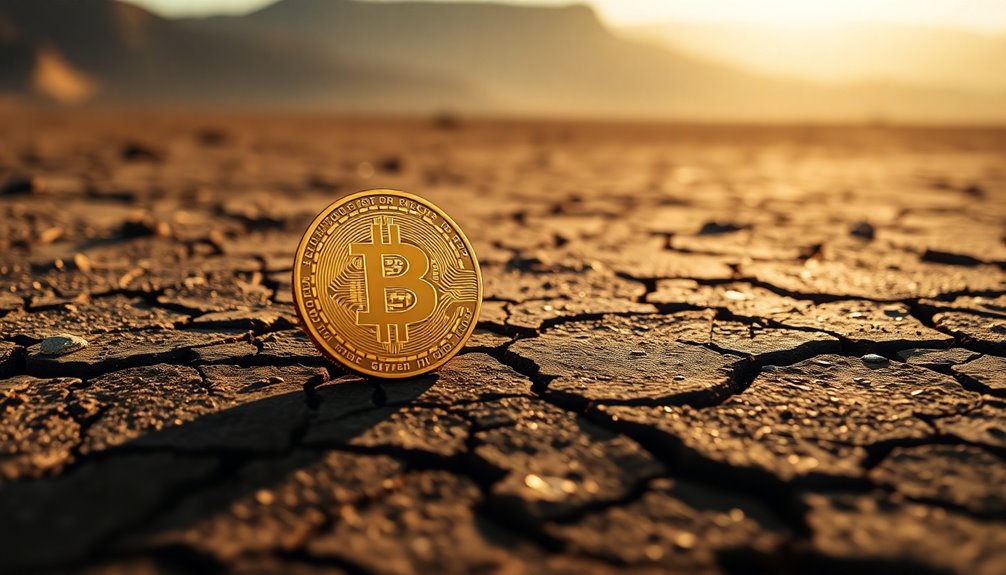
The mining process plays a vital role in Bitcoin's ecosystem, but as you look ahead, the finite supply of 21 million Bitcoins will significantly impact the network. Once this limit is reached around 2140, mining rewards will end, forcing miners to rely solely on transaction fees for income. As the block rewards halve every four years, you'll likely notice an increase in transaction fees, especially during busy times. This shift could make Bitcoin less appealing for small transactions, affecting its adoption. Additionally, the scarcity of Bitcoin enhances its value, making it a viable store of value. Furthermore, the transition to renewable energy in mining operations is becoming increasingly vital for sustainability as miners adapt to changing economic incentives. Ultimately, the finite supply creates a predictable monetary policy, contrasting sharply with inflationary fiat currencies, which can be printed at will.
Transaction Verification Mechanism

As you navigate the Bitcoin network, understanding the transaction verification mechanism is crucial for grasping how this decentralized system functions.
Each transaction starts with a public key, creating a bitcoin address for receiving funds, while the private key verifies ownership by signing transactions.
Once initiated, transactions are broadcasted to the network, where nodes check their authenticity and ensure sufficient funds. Invalid transactions are discarded, while valid ones are added to a block.
Miners then compete to solve complex algorithms, ensuring the transactions are hashed into unique identifiers. The verification process involves intricate scripts, matching signatures with public keys, ensuring that every transaction is secure and authorized before it's added to the blockchain. This process is essential as it prevents double-spending, maintaining the integrity of the Bitcoin network.
Pros and Cons of Scarcity
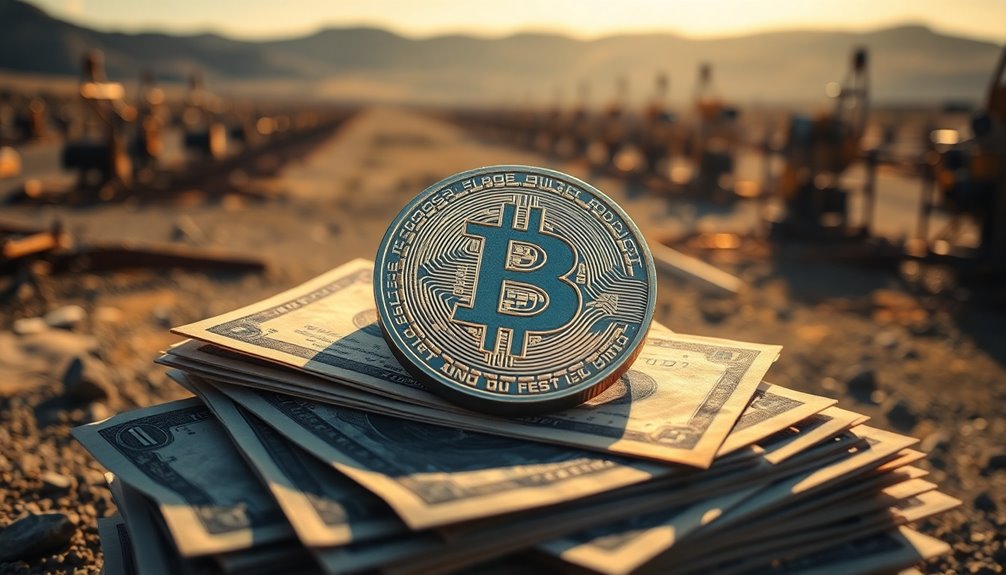
Understanding the transaction verification mechanism sets the stage for discussing the implications of Bitcoin's scarcity.
On the positive side, Bitcoin's predictable supply schedule, capped at 21 million coins, helps manage market expectations and shields you from inflation. The historical price appreciation following Halving events makes Bitcoin an attractive investment, especially during economic instability. This is further supported by the fact that gold and bitcoin share attributes that reinforce their roles as effective stores of value.
However, scarcity has its drawbacks. As Halving reduces mining rewards, miners may rely solely on transaction fees, which could threaten network security.
Additionally, the fixed supply can lead to extreme price volatility and speculation, making it challenging for some investors.
Lastly, limited growth in circulation may restrict Bitcoin's adoption, as its static supply doesn't adapt to market demand changes.
Bitcoin vs. Traditional Currencies
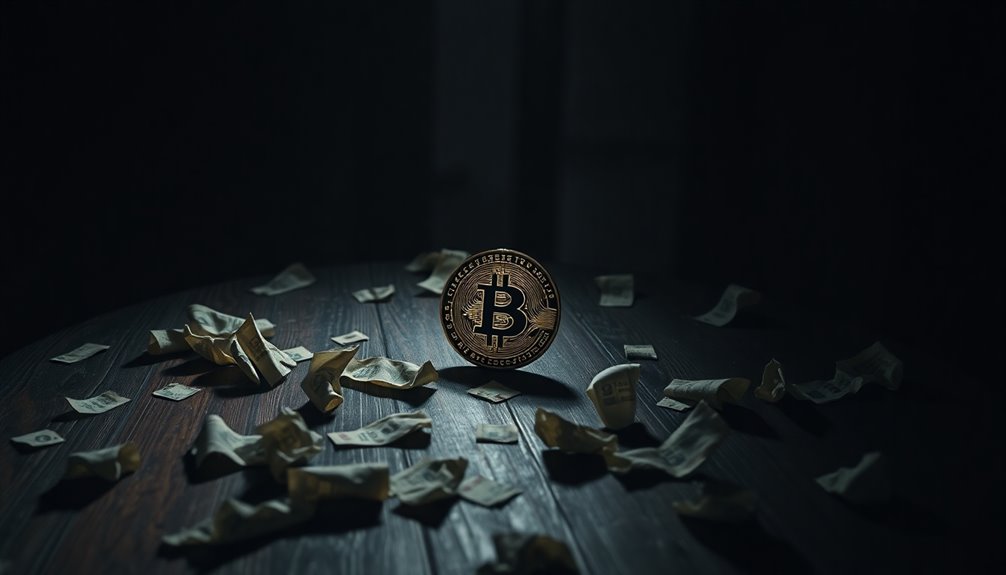
While many people appreciate the benefits of traditional currencies, Bitcoin and other cryptocurrencies present a compelling alternative.
Cryptocurrencies operate on decentralized networks, allowing you to make transactions directly with others without relying on banks or governments. This peer-to-peer system not only speeds up transactions but also reduces fees. Additionally, transaction speed and cost can significantly favor cryptocurrencies for cross-border transfers, often completing within minutes. Leasing with bad credit is also feasible in the financial landscape, providing more options for those who may struggle with traditional financing.
With blockchain technology, your transactions are secure and transparent, minimizing fraud risks. Unlike traditional currencies, which can be counterfeited or stolen, cryptocurrencies use cryptography to ensure safety.
However, traditional currencies boast wider acceptance and stability, making them easier to use in everyday situations.
Ultimately, while Bitcoin offers unique advantages, it's essential to consider both systems' strengths and weaknesses before deciding which suits your needs better.
Market Volatility Concerns
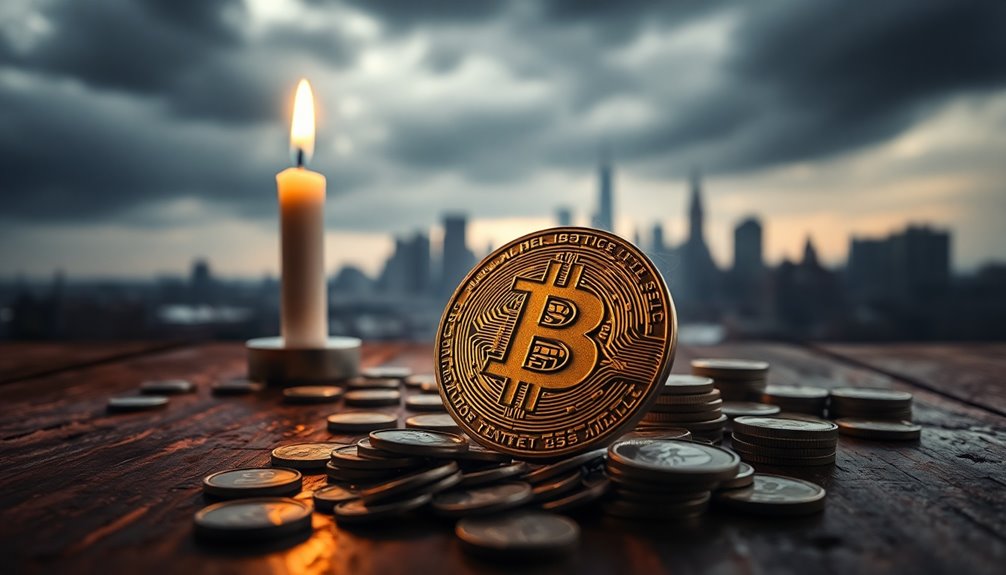
Market volatility is a pressing concern for Bitcoin investors, especially since the cryptocurrency's price can swing dramatically in short periods.
With a limited supply of 21 million coins, rising demand can lead to significant price increases. Halving events further reduce the supply of new Bitcoins, intensifying price competition. Indexed annuities can offer a level of protection against inflation, which is a crucial consideration for investors facing market fluctuations.
Large holders, or whales, can create supply shocks by buying or selling in bulk, causing sharp price movements due to limited liquidity. Emotional trading and investor sentiment also amplify volatility, as fear and greed drive market reactions. Large holders' trades can trigger substantial market reactions, further complicating the volatility landscape.
Economic factors, like inflation and global shifts, add another layer of unpredictability. As inflation impacts purchasing power, understanding these dynamics becomes essential for navigating Bitcoin's inherent volatility.
Regulatory Changes Affecting Cryptocurrency

As Bitcoin's market volatility captures attention, regulatory changes are becoming increasingly significant in shaping the future of cryptocurrency.
You're likely noticing a surge in regulatory activity as governments respond to the growing use of crypto by investors and businesses. Multiple regulators now have jurisdiction, which can create confusion for you as a user. They're focused on protecting consumers from fraud and ensuring compliance with anti-money laundering laws. Initiatives like the DOJ's National Cryptocurrency Enforcement Team show a commitment to tackling these issues. Moreover, global standards are essential due to the cross-border nature of crypto. As these frameworks evolve, you'll need to stay informed about how regulations may impact your investments and trading strategies. Additionally, the increased scrutiny from regulators focusing on consumer protection is reshaping the landscape for cryptocurrency users.
Hold for Long-Term Gains
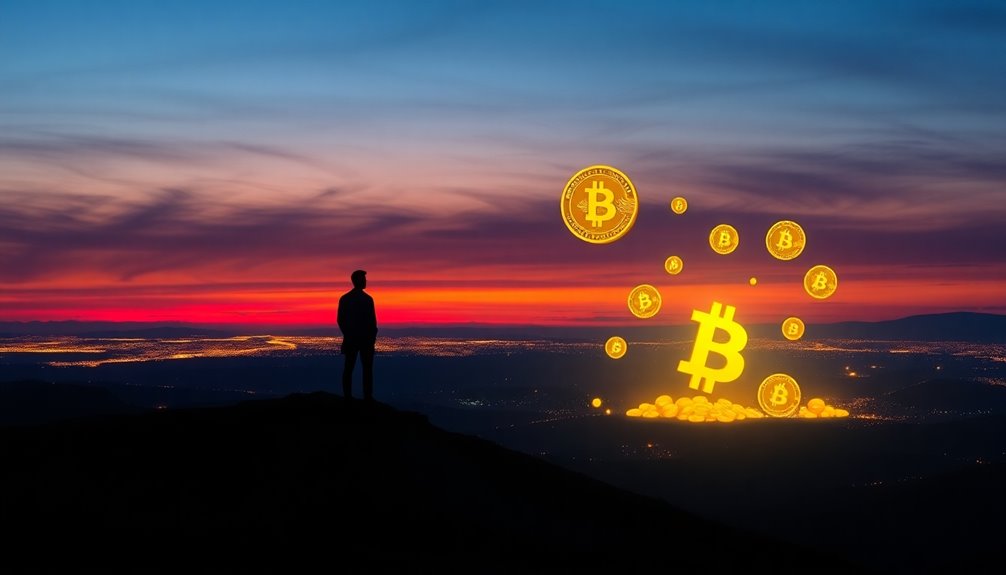
Investing in Bitcoin for the long term can be a smart strategy, especially considering its capped supply of 21 million coins. As all bitcoins are mined, Bitcoin shifts from an inflationary to a deflationary model, potentially boosting its value over time. While historical returns may not repeat, conservative estimates suggest a 10-year annualized return of around 5.7%. Additionally, with Bitcoin's current penetration estimated at about 1% of total wealth, this indicates significant room for growth and adoption in the future. To maximize gains, consider dollar-cost averaging, which allows you to invest small amounts regularly, mitigating the impact of price swings. This approach has shown to outperform other assets like gold in the past.
Frequently Asked Questions
What Will Happen to Transaction Fees After All Bitcoins Are Mined?
After all bitcoins are mined, transaction fees will become your primary way to incentivize miners.
As competition for transaction space increases, you may notice fees rising due to market demand. Miners will prioritize higher-fee transactions, making it crucial for you to adjust your fee offers accordingly.
If Bitcoin's value appreciates, this could offset any potential rise in fees, ensuring network security remains intact while keeping transactions efficient.
Can Bitcoins Still Be Lost or Rendered Inaccessible After Mining Is Complete?
Yes, bitcoins can still be lost or made inaccessible even after all bitcoins are mined. If you lose your private key, those bitcoins become irretrievable, remaining on the blockchain but unspendable.
Additionally, issues like corrupted hard drives or forgotten seed phrases can render bitcoins inaccessible.
With millions of bitcoins estimated lost, the impact on the overall supply continues, making recovery a daunting challenge unless specific conditions are met.
How Will Miners Earn Revenue Without Block Rewards?
Imagine you're a miner who's just finished verifying transactions on the Bitcoin network.
Once block rewards disappear, you'll rely on transaction fees for your income. As demand for transactions increases, these fees could rise, making your work more profitable.
If more users want to send Bitcoin, you'll have a stronger incentive to keep mining efficiently.
This shift ensures that the network remains secure and functional, even without block rewards.
What Role Will Bitcoin Play in the Global Economy Post-Mining?
Bitcoin's role in the global economy will likely evolve significantly after its mining phase.
You'll see it become a more prominent store of value, similar to digital gold, driven by its capped supply. As demand increases, its scarcity could push prices up.
Additionally, Bitcoin may facilitate cross-border transactions, reducing reliance on traditional banking systems.
However, regulatory frameworks and environmental considerations will shape how widely it's adopted and integrated into financial systems.
Will Bitcoin's Mining Difficulty Change After Reaching the Cap?
Imagine a tightrope walker, balancing perfectly as the crowd watches. That's how Bitcoin's mining difficulty adjusts, ensuring stability.
Even after the 21 million cap is reached, the difficulty won't just vanish. It'll continue to adapt every 2,016 blocks, responding to the total computational power of miners.
As long as you and others contribute, the network's balance will remain intact, keeping the process smooth and secure despite the changing incentives.
Conclusion
As all bitcoins are mined, you might wonder how this will affect its value and your investment. With a finite supply, scarcity could drive prices up, but it also raises questions about market stability and transaction fees. While traditional currencies can be printed endlessly, Bitcoin's design encourages long-term holding. Are you ready to navigate this evolving landscape and adapt your strategy as mining concludes? Embrace the change, and you could find new opportunities in the crypto world.









